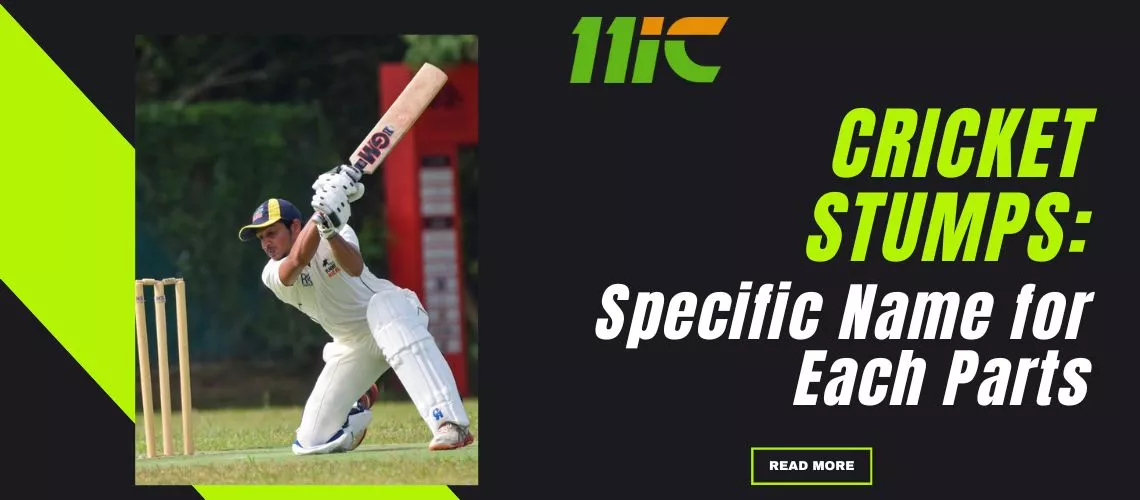Cricket Stumps: Specific Name for Each Parts
Making sure you have cricket stumps to practice with is essential for anybody preparing to play cricket, whether they are amateur or professional.
In cricket, the stumps and bails together form the wicket, located at the end of the pitch. In order for the ball to strike the stumps, the bowler often tries to bowl it in a certain way. The bowler knocks out or dismisses the batsman in a process called stumping or getting stumped.
Cricket Terms for Stumps
In cricket, the term “stumps” has three distinct meanings. In addition to serving as a means of dismissal and a necessary piece of equipment for the sport, stumps are also used to denote the conclusion of a play day.
Method of dismissal
According to cricket rules, a batter gets “stumped” when they are out of their crease, and the wicketkeeper removes the bails. Moreover, in the event of a run-out or bowling, the players must disturb the stumps. Therefore, stumps are essential to many dismissal strategies.
Playing for the day's end
In cricket, stumps are sometimes used to indicate the conclusion of a game. The phrase applies in the longest format of cricket, encompassing four- to five-day Test and First-Class matches. The umpires declare stumps, signaling the end of play for the day, when the players bowl the last delivery of the match. The umpires remove the stumps to indicate the end of the day’s play. However, they often remove the bail at the conclusion of a session, just in time for lunch or tea.
What Are Cricket Stumps Used For?
Since they establish whether the bowler or batsman has gained a point, the stumps are a crucial component of the game.
The bails are good if they’re still on the stumps, that’s for sure! When the wicket shatters, it happens because the bail falls after the ball strikes it.
TV audiences get a whole new view in professional matches thanks to a camera hidden inside one of the stumps. This stump cam captures the action up close, giving viewers a unique angle they wouldn’t normally see. This gives spectators a close-up look at the bowler and batter as they compete on the field.
Building of the Cricket Stumps
The stumps consist of three upright supports that sustain two bails each. The stumps and bails of the wicket are all constructed of wood, sometimes known as ash. Each stump measures 28 inches (71.1 cm) in height and ranges in diameter from 1.5 inches (3.81 cm) to 1.38 inches (3.49 cm). One end of the stumps has a spike. These spikes aid in the stumps’ entry into the earth. A U-shaped groove on top of the stump aids in the placement and stability of the bails.
Off Stump
- This stump stands on the offside of the wicket, which is also the side the batsman used to place his bat on.
- Aligned with the batsman’s off side, this stump becomes the key target for bowlers aiming for an outright dismissal. Hitting the off stump with the ball dislodges the bails, resulting in a bowled wicket. Deliveries aimed here are often fast and swingy, testing the batsman’s reflexes and technique.
Middle Stump
- Positioned between the two exterior stumps (leg stump and off stump), it is the center stump.
- Aligned with the batsman’s offside, this stump becomes the key target for bowlers aiming for an outright dismissal. Hitting the off stump with the ball dislodges the bails, resulting in a bowled wicket. Deliveries aimed here are often fast and swingy, testing the batsman’s reflexes and technique.
Leg Stump
- According to the batsman’s legs, it is the stump that is now on the on-side of the wicket.
- Standing on the batsman’s on side, the leg stump offers a slightly different challenge. While hitting here can still result in a bowled dismissal, it’s also the target for deliveries aiming for “lbw with an appeal.” This means the bowler needs to convince the umpire that the ball would’ve clipped the leg stump despite hitting the batsman’s pads.
Beyond Names: The Specific Parts of a Stump
While the three stumps stand as a whole, each individual stump consists of distinct parts:
1. Grooves
These shallow indentations on the top of each stump hold the bails in place. Their depth and width play a crucial role in how easily the bails dislodge upon contact with the ball.
2. Shoulder
The wider section at the top of the stump, directly below the grooves. It offers additional support and stability.
3. Body
The main shaft of the stump is responsible for providing the overall height and structure.
4. Base
The pointed end of the stump that gets driven into the ground. This ensures that it remains firmly rooted despite the intense force of the deliveries.
The quality and dimensions of these individual parts are strictly regulated to ensure fair play and consistency across different levels of cricket.
How Far Apart Are the Stumps?
Typically, each wicket has a lengthy, round form. Every stump has a spike on one end that players insert into the ground. On the other hand, the bails rest on a U-shaped groove on the other end. In cricket at the junior level, the stumps are smaller.
Each pair of wickets must be 9 inches (22.86 cm) wide. This is according to the sport’s official regulations, and the bails that sit atop the stumps must be 4.31 inches (10.95 cm) long.
To provide the foundation of the wicket, which allows the bails to rest properly, players space the stumps closely together. Because of this, players must space the stumps slightly less than this width apart to allow the bails to easily slide into the grooves above them.
The Cricket Stumps' Evolution and History
In 1775, players were using all three sets of stumps. Before then, cricket only utilized a set of two stumps. Recent modifications have added the sponsor’s logo to the stumps. These days, broadcasters also utilize stump cameras to provide a distinctive perspective for action replays. This is particularly effective especially when a bowler bowls out a batsman. Red LEDs—also referred to as Zing Bails—help the stumps thanks to new technological advancements. The lights come on only when a ball makes a direct hit on the stumps. 2014 saw the debut of the LED stumps in the ICC World Twenty20. Since then, players have used the newly redesigned stumps for all limited-overs matches and day/night tests.
Variations in Cricket Stumps
Various forms of cricket stumps distinguish themselves primarily by the materials used in their construction. Discovering which type is suitable for your terrain requires some research. Each one offers unique advantages and difficulties for players.
Cricket Stumps Made of Wood
Professional cricket pitches typically use wooden stumps, which are typically composed of ash. Traditional wooden stumps add a vintage sense to the landscape. Though they can be more prone to warping over time, wooden cricket stumps can have the drawback of being less durable than certain other varieties. However, they are still commonly used due to their traditional appeal and affordability. While using high-quality ash wood and varnishing it may help prolong the life of your stumps. However, they may not be able to bear the repeated blows of a fast-moving cricket ball. This can lead to frequent replacements and increased maintenance costs.
Cricket Stumps Made of Metal
One benefit of metal cricket stumps is their extreme durability. This feature allows users to store them outside without much harm. In contrast to wooden stumps, metal stumps are often freestanding and do not require hammering into the ground. They are therefore perfect for anyone who wants to practice at home without damaging their grass by creating holes in it. It is not possible to knock down the bails and fully enjoy the game of cricket while using some metal cricket stumps. This happens because manufacturers fasten them to the wicket as a single unit.
Cricket Stumps Made of Plastic
Plastic cricket stumps are less expensive than wooden ones. So, if you’re looking for something simple and inexpensive to practice your bowling or batting, they might be a suitable alternative. However, professional cricket grounds don’t often use them. Similarly to metal stumps, these durable products are often one solid piece. That’s why it’s challenging to play cricket to its fullest extent.
LED-lighted Cricket Stumps
LED stumps have taken on the role of wooden stumps in contemporary cricket in a number of T20 tournaments worldwide. Additionally, “zing” bails—bails that have red LEDs incorporated in them—are also available. They work especially well in low-visibility situations. This is because they let the bowler see the wicket between the batsman’s legs in inclement weather. The more recent version, known as LED cricket stumps or light-up stumps, is lighter than the conventional wooden stumps.
Conclusion
In the world of cricket, where bat and ball dictate the game’s pace, each part holds importance. From the tall stumps to their detailed components, cricket is more than just a sport; it’s a blend of tradition and accuracy.
Exploring the structure of cricket stumps reveals a story filled with purpose and tradition. From the strong stump base rooted in the ground to the fragile bails placed on top, every piece contributes to the unfolding drama on the field.















